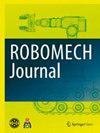行星探测车承载能力与振动参数关系的实验研究
IF 1.7
Q3 INSTRUMENTS & INSTRUMENTATION
引用次数: 0
摘要
近年来,具有腿部机构的机器人作为高速运行的行星探测机器人受到了广泛的关注。进行行星探测的漫游者需要出色的运行性能,以便在松散的地面上行驶,因为它们通常会打滑,几乎无法前进。探测车的运动很容易使松散地面的表面变形。这个问题可以通过增加承载力来解决。承载能力,即月球车腿与地面接触时施加的阻力,需要足够大,以防止有腿的月球车在松散的地面上滑动。通过传递振动使地面压实,可以增加承载能力。研究了水平方向承载能力与振动参数之间的关系,为提高腿式探测车的运行性能提供了有价值的信息。首先,研究了改变振动参数对承载能力的影响。实验结果表明,承载能力与振动加速度有关。这些结果表明,可以通过振动加速度来估计其承载能力。然后,将频率和幅值作为振动参数进行比较,设计出有效的提高承载力的方法。试验结果表明,高振幅振动比高频振动更能提高承载能力。原因是高振幅振动比高频振动产生更大的额外振动,这是由杆与地面之间的碰撞产生的。这些知识对于选择合适的振动,有效地提高承载能力是有价值的。这项研究提出了一种利用有腿探测车促进进一步行星探索的方法。本文章由计算机程序翻译,如有差异,请以英文原文为准。
Experimental investigation of relationship between bearing capacity and vibration parameters for planetary exploration legged rovers
In recent years, robots with leg mechanisms have received considerable attention as high-running planetary exploration rovers. Rovers undertaking planetary exploration require outstanding running performance to travel on loose ground on which they mostly slip and hardly move forward. The movement of the rover easily deforms the surface of loose ground. This problem can be solved by increasing the bearing capacity. The bearing capacity, the resistance force exerted on the rover legs when they make contact with the ground, needs to be sufficiently large to prevent legged rovers from slipping on loose ground. The bearing capacity can be increased by compaction of the ground by imparting vibrations. This study investigates the relationship between the bearing capacity in the horizontal direction and vibration parameters because this relationship offers valuable information for improving the running performance of legged rovers. First, we investigated the effect of changing the vibration parameters on the bearing capacity. Our experimental results show that the bearing capacity is related to vibration acceleration. These results suggest that the bearing capacity can be estimated from the vibration acceleration. Next, the frequency and amplitude were compared as vibration parameters to devise an efficient method for increasing the bearing capacity. The results of these experiments showed that high-amplitude vibrations increase the bearing capacity to a greater extent than high-frequency vibrations. The reason is that high-amplitude vibrations generate larger additional vibrations by the collision between the rod and the ground than high-frequency vibrations. This knowledge is valuable for selecting a suitable vibration that can efficiently increase the bearing capacity. This study suggests a method of facilitating further planetary exploration using legged rovers.
求助全文
通过发布文献求助,成功后即可免费获取论文全文。
去求助
来源期刊

ROBOMECH Journal
Mathematics-Control and Optimization
CiteScore
3.20
自引率
7.10%
发文量
21
审稿时长
13 weeks
期刊介绍:
ROBOMECH Journal focuses on advanced technologies and practical applications in the field of Robotics and Mechatronics. This field is driven by the steadily growing research, development and consumer demand for robots and systems. Advanced robots have been working in medical and hazardous environments, such as space and the deep sea as well as in the manufacturing environment. The scope of the journal includes but is not limited to: 1. Modeling and design 2. System integration 3. Actuators and sensors 4. Intelligent control 5. Artificial intelligence 6. Machine learning 7. Robotics 8. Manufacturing 9. Motion control 10. Vibration and noise control 11. Micro/nano devices and optoelectronics systems 12. Automotive systems 13. Applications for extreme and/or hazardous environments 14. Other applications
 求助内容:
求助内容: 应助结果提醒方式:
应助结果提醒方式:


